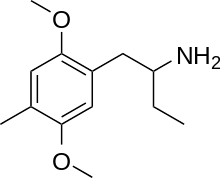Ariadne (psychedelic)
Ariadne (also known as 4C-D, α-Et-2C-D, BL-3912, or dimoxamine) is a lesser-known psychedelic drug. It is a homologue of 2C-D and DOM. Ariadne was first synthesized by Alexander Shulgin. In his book PiHKAL, Shulgin reported testing Ariadne up to a dose of 32 mg, and reported that it produces psychedelia at a bare threshold.[1] Very little data exists about the pharmacological properties, metabolism, and toxicity of Ariadne in humans apart from Shulgin's limited testing.
 | |
| Names | |
|---|---|
| IUPAC name
1-(2,5-Dimethoxy-4-methylphenyl)butan-2-amine | |
| Other names
4-Methyl-2,5-dimethoxy-alpha-ethylphenethylamine 4-Methyl-2,5-dimethoxybutanamine | |
| Identifiers | |
CAS Number |
|
3D model (JSmol) |
|
| ChemSpider | |
PubChem CID |
|
InChI
| |
SMILES
| |
| Properties | |
Chemical formula |
C13H21NO2 |
| Molar mass | 223.316 g·mol−1 |
Except where otherwise noted, data are given for materials in their standard state (at 25 °C [77 °F], 100 kPa). | |
| Infobox references | |
In more an animal study, Ariadne was shown to produce stimulus generalization in rats trained to respond to the drug MDMA.[2]
References
- Shulgin, Alexander; Ann Shulgin (September 1991). PiHKAL: A Chemical Love Story. Berkeley, California: Transform Press. ISBN 0-9630096-0-5. OCLC 25627628.
- Glennon RA (1993). "MDMA-like stimulus effects of alpha-ethyltryptamine and the alpha-ethyl homolog of DOM". Pharmacol Biochem Behav. 46 (2): 459–462. PMID 7903460.
This article is issued from
Wikipedia.
The text is licensed under Creative
Commons - Attribution - Sharealike.
Additional terms may apply for the media files.